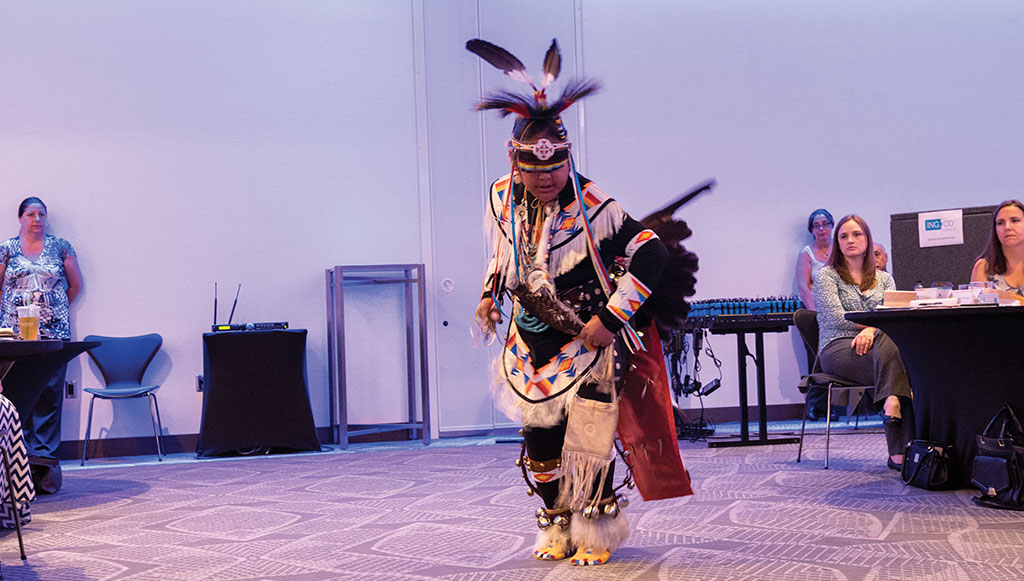It took only a few minutes for 10-year old Ashton Fish to express for everyone at the 2017 AMBER Alert Symposium, through both word and dance, why everything possible must be done to protect missing and abducted children in Indian Country.
“I want to be the voice for all the Indian children,” said Fish. “I want the AMBER Alert to be on the reservation so none of our children can go missing, no one can steal our children and we won’t be afraid to walk in the dark.”
The young man then performed a traditional dance for all missing children. Fish first became aware of the issue of for Native American children when he heard about the abduction and murder of 11-year-old Ashlynne Mike on the Navajo Reservation in May 2016. Fish created a YouTube video (https://youtu.be/vStdaD1zq_g) to perform a dance in honor of Ashlynne Mike and to plead for all parents to watch over their children.
“I have been called by the Spirits to come around here and dance for Ashlynne Mike and all the other stolen kids,” said Fish on the video. “I dedicate this song for all the children, the aunts who are sad. Aho!”
Fish is a member of the Assiniboine Nation and traveled from Blackfoot, Idaho, to speak and dance at the symposium. His grandmother, Kristen Lowdog, said her grandson’s dancing is a good way for Native Americans to combat this problem because it involves their own culture and ways.
“He is very spiritually mature and voices his opinion out,” said Lowdog. “He has a big heart and he wants to do what he can to help.”
The artistry of Ashton’s expression of dance, combined with the wisdom of his words and vision for AMBER Alert’s protection of children on tribal lands, left symposium participants eager to meet this young man and shake his hand following the presentation.
Ashton and his grandmother presented AATTAP Program Administrator Jim Walters with a handmade ceremonial quilt in honor of his work with AMBER Alert and Child Protection in Indian Country.
CHALLENGES IN INDIAN COUNTRY
AATTAP director Jim Walters has been working for years to help bring training and resources to Indian Country. Although much has been accomplished, he said most tribes do not have what is needed to slow the tide of missing and abducted children from their communities.
“Child abductions are down in the U.S. with one exception, and that is in Indian Country,” said Walters. “Children in Indian Country are especially vulnerable.”
Walters emphasized the problem of lacking data on missing and abducted children from tribal lands, noting the actual numbers are unknown because no federal or Native American agency is collecting that information.
Walters cited the murder of Ashlynne Mike as a tragic example of the challenges being faced in Indian Country. When Ashlynne was first discovered missing on May 3, 2016, her brother ran two-and-a-half miles to find a car with a phone—but the phone did not work. Twelve hours into the investigation, authorities were still unclear whether the state or the tribe should issue an AMBER Alert.
“Our priority is to save lives,” said Walters. “We can work out the jurisdictional issues later.”
The Navajo Nation is now working with Arizona and Utah to improve the AMBER Alert program on the reservation.
Walters offered other examples of unique challenges in Indian Country.
- The unique history of cultural intervention and jurisdictional complexities
- High turnover and lack of staffing
- Lack of understanding of Indian Child Welfare laws
- Use of the internet to lure Native American children away from their homes, yet these children are most often reported as runaways
Ashlynne Mike’s case did bring to light one very strong feature of Native American communities – they have the best trackers in the world. Walters gave examples of the superior skill and coordination tribal law enforcement and community members demonstrate when conducting searches. He discussed other child protection efforts and collaborative approaches that can help make a difference in Native American community efforts to prevent child exploitation and abduction.
- Needs assessments should and will continue to be conducted in more than 100 Native American communities
- State and community strategies with strong leadership from the tribal government must be developed
- Child Abduction Response Teams (CARTs) comprised of tribal, state and federal agencies should be championed, developed and maintained
- Prevention education in elementary schools and additional training for law enforcement should be developed as a key component of a comprehensive child protection strategy
“Children are a precious resource,” said Walters. “We have to take a tribal approach where every member is responsible for the community. We want to assure the victim’s family and community that all resources are utilized in the successful recovery of a child.”
More information about child protection resources available for Indian Country can be found at the Tribal Database website – https://www.amber-ic.org.

